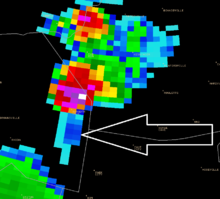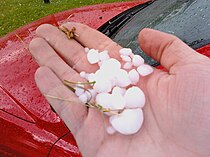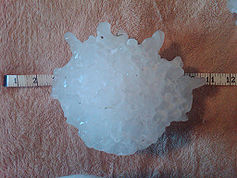| Part of the Nature series on Weather |
| Calendar seasons |
|---|
| Spring · Summer Autumn · Winter |
| Dry season · Wet season |
| Storms |
| Thunderstorm · Supercell Downburst · Lightning Tornado · Waterspout Tropical cyclone (Hurricane) Extratropical cyclone Winter storm · Blizzard · Ice storm Dust storm · Firestorm · Cloud |
| Precipitation |
| Drizzle · Rain · Snow · Graupel Freezing rain · Ice pellets · Hail |
| Topics |
| Meteorology · Climate Weather forecasting Heat wave · Air pollution |
| Weather portal |
Unlike ice pellets, hail stones are layered and can be irregular and clumped together. Hail is composed of transparent ice or alternating layers of transparent and translucent ice at least 1 millimetre (0.039 in) thick, which are deposited upon the hail stone as it cycles through the cloud multiple times, suspended aloft by air with strong upward motion until its weight overcomes the updraft and falls to the ground. There are methods available to detect hail-producing thunderstorms using weather satellites and radar imagery. Hail stones generally fall at higher speeds as they grow in size, though complicating factors such as melting, friction with air, wind, and interaction with rain and other hail stones can slow their descent through Earth's atmosphere. Severe weather warnings are issued for hail when the stones reach a damaging size, as it can cause serious damage to man-made structures and, most commonly, farmers' crops. In the United States, the National Weather Service issues severe thunderstorm warnings for hail 1" or greater in diameter. This threshold, effective January 2010, marked an increase over the previous threshold of 3/4" hail. The Service made the change for two main reasons: a) public complacency and b) recent research suggesting that damage does not occur until a hailstone reaches 1" in diameter.
Contents
|
Formation
Like other precipitation, hail forms in cumulonimbus clouds when supercooled water droplets freeze on contact with condensation nuclei. The storm's updraft, with upwardly directed wind speeds as high as 110 miles per hour (180 km/h),[2] blow the hailstones back up the cloud. The updraft dissipates and the hailstones fall down, back into the updraft, and are lifted up again. These type of strong updrafts can also indicate the presence of a tornado.[3] Any thunderstorm which produces hail that reaches the ground is known as a hailstorm.[4] Hail has a diameter of 5 millimetres (0.20 in) or more.[1] Stones just larger than golf ball-sized are one of the most frequently reported hail sizes.[5] Hail stones can grow to 15 centimetres (6 in) and weigh more than 0.5 kilograms (1.1 lb).[6] In large hailstones, latent heat released by further freezing may melt the outer shell of the hailstone. The hailstone then may undergo 'wet growth', where the liquid outer shell collects other smaller hailstones.[7] The hailstone gains an ice layer and grows increasingly larger with each ascent. Once a hail stone becomes too heavy to be supported by the storm's updraft, it falls from the cloud.[8]Hail forms in strong thunderstorm clouds, particularly those with intense updrafts, high liquid water content, great vertical extent, large water droplets, and where a good portion of the cloud layer is below freezing 0 °C (32 °F).[1] The growth rate is maximized where air is near a temperature of −13 °C (9 °F). Hail growth becomes vanishingly small when air temperatures fall below −30 °C (−22 °F) as supercooled water droplets become rare at these temperatures.[9] Around thunderstorms, hail is most likely within the cloud at elevations above 20,000 feet (6,100 m). Between 10,000 feet (3,000 m) and 20,000 feet (6,100 m), 60 percent of hail is still within the thunderstorm, though 40 percent now lies within the clear air under the anvil. Below 10,000 feet (3,000 m), hail is equally distributed in and around a thunderstorm to a distance of 2 nautical miles (3.7 km).[10]
Hail is most common within continental interiors of the mid-latitudes, as hail formation is considerably more likely when the freezing level is below the altitude of 11,000 feet (3,400 m).[9] Movement of dry air into strong thunderstorms over continents can increase the frequency of hail by promoting evaporational cooling which lowers the freezing level of thunderstorm clouds giving hail a larger volume to grow in. Accordingly, hail is actually less common in the tropics despite a much higher frequency of thunderstorms than in the mid-latitudes because the atmosphere over the tropics tends to be warmer over a much greater depth. Hail in the tropics occurs mainly at higher elevations.[11]

Severe thunderstorms containing hail can exhibit a characteristic green coloration[12]
Climatology
Hail occurs most frequently within continental interiors at mid-latitudesis and is less common in the tropics, despite a much higher frequency of thunderstorms than in the midlatitudes.[13] Hail is also much more common along mountain ranges because mountains force horizontal winds upwards (known as orographic lifting), thereby intensifying the updrafts within thunderstorms and making hail more likely.[14] One of the more common regions for large hail is across mountainous northern India, which reported one of the highest hail-related death tolls on record in 1888.[15] China also experiences significant hailstorms.[16] Central Europe experiences also a lot of hailstorms. Popular regions for hailstorms are southern and western Germany, northern and eastern France and southern and eastern BeNeLux. In south-eastern Europe, Croatia experiences frequent occurrences of hail.[17]In North America, hail is most common in the area where Colorado, Nebraska, and Wyoming meet, known as "Hail Alley." [18] Hail in this region occurs between the months of March and October during the afternoon and evening hours, with the bulk of the occurrences from May through September. Cheyenne, Wyoming is North America's most hail-prone city with an average of nine to ten hailstorms per season.[19]
Short-term detection
Modern radar scans many angles around the site. Reflectivity values at multiple angles above ground level in a storm are proportional to the precipitation rate at those levels. Summing reflectivities in the Vertically Integrated Liquid or VIL, gives the liquid water content in the cloud. Research shows that hail development in the upper levels of the storm is related to the evolution of VIL. VIL divided by the vertical extent of the storm, called VIL density, has a relationship with hail size, although this varies with atmospheric conditions and therefore is not highly accurate.[20] Traditionally, hail size and probability can be estimated from radar data by computer using algorithms based on this research. Some algorithms include the height of the freezing level to estimate the melting of the hailstone and what would be left on the ground.
Certain patterns of reflectivity are important clues for the meteorologist, too. The three body scatter spike is one of them. This is the result of energy from the radar hitting hail and being deflected to the ground, where they deflect back to the hail and then to the radar. The energy took more time to go from the hail to the ground and back, as opposed to the energy that went direct from the hail to the radar, and the echo is further away from the radar than the actual location of the hail on the same radial path, forming a cone of weaker reflectivities.
More recently, the polarization properties of weather radar returns have been analyzed to differentiate between hail and heavy rain.[21][22] The use of differential reflectivity (Zdr), in combination with horizontal reflectivity (Zh) has led to a variety of hail classification algorithms[23] Visible satellite imagery is beginning to be used to detect hail, but false alarm rates remain high using this method.[24]
Size and terminal velocity
The size of hail stones is best determined by measuring their diameter with a ruler. In the absence of a ruler, hail stone size is often visually estimated by comparing its size to that of known objects, such as coins.[25] Below is a table of commonly used objects for this purpose.[26] Note that using the objects such as hen's eggs, peas, and marbles for comparing hailstone sizes is often inaccurate, due to their varied dimensions. The UK organisation, TORRO, also scales for both hailstones and hailstorms.[27] When observed at an airport, METAR code is used within a surface weather observation which relates to the size of the hail stone. Within METAR code, GR is used to indicate larger hail, of a diameter of at least 0.25 inches (6.4 mm). GR is derived from the French word grêle. Smaller-sized hail, as well as snow pellets, use the coding of GS, which is short for the French word grésil.[28]Terminal velocity of hail, or the speed at which hail is falling when it strikes the ground, varies by the diameter of the hail stones. A hail stone of 1 centimetre (0.39 in) in diameter falls at a rate of 9 metres per second (20 mph), while stones the size of 8 centimetres (3.1 in) in diameter fall at a rate of 48 metres per second (110 mph). Hail stone velocity is dependent on the size of the stone, friction with air it is falling through, the motion of wind it is falling through, collisions with raindrops or other hail stones, and melting as the stones fall through a warmer atmosphere.[29]
| United States | Canada | |
|---|---|---|
| Dime | 0.705 inches (17.9 mm)[30] | 18.03 millimetres (0.710 in) |
| Cent (or "Penny") | 0.75 inches (19 mm)[31] | 19.05 millimetres (0.750 in) |
| Five cents (Nickel) | 0.88 inches (22 mm)[31] | 21.2 millimetres (0.83 in) |
| Twenty-five cents (Quarter dollar) | 1.00 inch (25 mm)[31] | 23.88 millimetres (0.940 in) |
| Dollar (Loonie) | 1.043 inches (26.5 mm) | 26.5 millimetres (1.04 in) |
| 50 Cents/Half Dollar | 1.25 inches (32 mm)[31] | 27.13 millimetres (1.068 in) |
| Two Dollars (Toonie) | 28 millimetres (1.1 in) |

A large hailstone, approximately 5 1/4 inches in diameter, that fell in Harper, Kansas on May 14, 2004.
| Object | Diameter |
|---|---|
| Pea | .25 inches (6.4 mm)[31] |
| Marble (small) | .50 inches (13 mm)[31] |
| Walnut/Ping-pong ball | 1.50 inches (38 mm)[31] |
| Golf ball | 1.75 inches (44 mm)[31] |
| Lime/Hen egg | 2.00 inches (51 mm)[31] |
| Tennis ball | 2.50 inches (64 mm)[31] |
| Cricket ball | 71 millimetres (2.8 in) |
| Baseball | 2.75 inches (70 mm)[31] |
| Apple/Teacup | 3.00 inches (76 mm)[31] |
| Grapefruit | 4.00 inches (102 mm)[31] |
| Softball | 4.50 inches (114 mm)[31] |
| Computer CD | 128 millimetres (5.0 in) |
Hazards
Main article: List of costly or deadly hailstorms
Hail can cause serious damage, notably to automobiles, aircraft, skylights, glass-roofed structures, livestock, and most commonly, farmers' crops.[19] Hail damage to roofs often goes unnoticed until further structural damage is seen, such as leaks or cracks. It is hardest to recognize hail damage on shingled roofs and flat roofs, but all roofs have their own hail damage detection problems.[32] Metal roofs are fairly resistant to hail damage, but may accumulate cosmetic damage in the form of dents and damaged coatings.[33]Hail is one of the most significant thunderstorm hazards to aircraft.[34] When hail stones exceed 0.5 inches (13 mm) in diameter, planes can be seriously damaged within seconds.[35] The hailstones accumulating on the ground can also be hazardous to landing aircraft. Hail is also a common nuisance to drivers of automobiles, severely denting the vehicle and cracking or even shattering windshields and windows. Wheat, corn, soybeans, and tobacco are the most sensitive crops to hail damage.[15] Hail is one of Canada's most expensive hazards.[36] Rarely, massive hailstones have been known to cause concussions or fatal head trauma. Hailstorms have been the cause of costly and deadly events throughout history. One of the earliest recorded incidents occurred around the 9th century in Roopkund, Uttarakhand, India.[37] The largest hailstone in terms of diameter and weight ever recorded in the United States fell on July 23, 2010 in Vivian, South Dakota in the United States; it measured 8 inches (20 cm) in diameter and 18.62 inches (47.3 cm) in circumference, weighing in at 1.93 pounds (0.88 kg).[38] This broke the previous record for diameter set by a hailstone 7 inches diameter and 18.75 inches circumference which fell in Aurora, Nebraska in the United States on June 22, 2003, as well as the record for weight, set by a hailstone of 1.67 pounds (0.76 kg) that fell in Coffeyville, Kansas in 1970.[38]








No comments:
Post a Comment